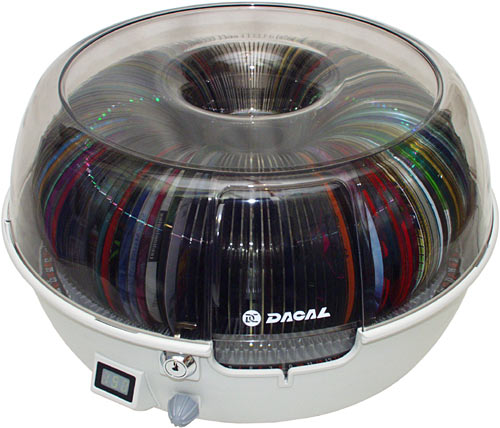
Quick Shot review 5: Dacal Technology CD Library II Review date: 3 October 2003. Last modified 03-Dec-2011. I 's DC-101 CD Library more than a year ago now. The new DC-300 can briefly be described as the same thing, only more so. If you want a fairly automatic indexing system for a bunch of 120mm discs, one or more DC-300s will provide it. The Dacal CD Libraries aren't CD/DVD jukeboxes; they contain no drive mechanism, and can't read the discs you put in them.

They're just motorised, database-backed, USB-connected disc es with 150 slots on a carousel. You can use controls on the Library to dial up a particular slot (whereupon the carousel rotates to the right point, and a pusher arm delivers your disc), but you can also connect the Library to a PC or Mac (the DC-101 was Windows-only) and create a database of disc contents, so you can easily look up the one you want. Select the right disc, and the carousel and ejector do their thing, once again. The CD Libraries may not be able to read discs, but they're much cheaper than similarly capacious libraries that can. Nitro.Pdf.6.X.7.X-Patch.Deepzero Free Download here. Here in Australia, Aus PC Market sell the DC-300 for $AU209, including Sydney metropolitan delivery (delivery to the rest of Australia costs more; the DC-300 isn't very heavy, but it's not small). Preset Viewer Breeze Keygen there. The new CD Library is better looking than the old one.which resembled a miniature greenhouse.
The new design with its small, dark windows ought to minimise damage to writable discs from sunlight. The difference is more than skin deep, though. In place of the DC-101's simple knob for manual slot selection, the DC-300 has a proper keypad. Many users won't be touching the keypad all that often, of course; you're meant to control the Library from a PC.
But manual control is still a welcome addition. The DC-300 is also likely to deliver your disc rather faster than the DC-101; the old model could only turn clockwise, so going one slot anticlockwise required it to spin almost completely around. The DC-300 can spin both ways, which reduces the worst-case access time to about five seconds. There's still a key-lockable door over the disc in/out hole, which provides about the same level of security as it did for the DC-101 - which is to say, practically none. It'll stop casual disc-pinching or rearranging (with no onboard reader, a disc that's been replaced in the wrong slot can be very annoying to find), and it ought to also prevent younger family members from feeding into the Library.